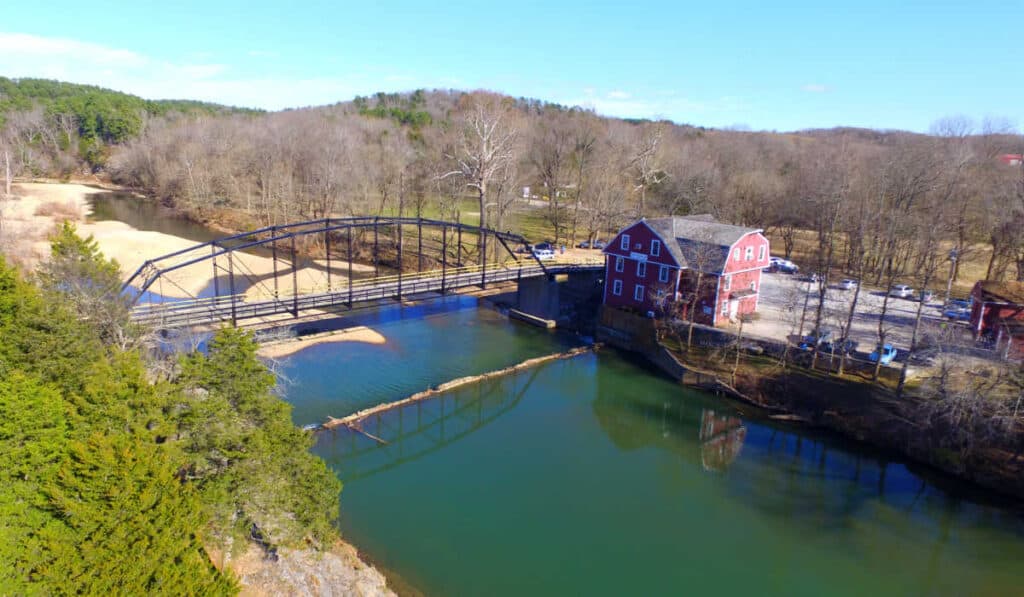Arkansas is home to a diverse range of snake species, showcasing a variety of colors, sizes, and characteristics. It’s important for residents and visitors alike to be familiar with the different types of snakes in the area, as some can be potentially dangerous due to their venomous nature. In total, there are 38 snake species found across the state, inhabiting various habitats from forests and wetlands to residential areas.
Out of the numerous species present in Arkansas, six are considered venomous, posing potential threats to humans in case of a bite. These include the Northern Cottonmouth, Eastern Copperhead, Timber Rattlesnake, Pygmy Rattlesnakes, Western Diamond-backed Rattlesnake, and Texas Coralsnake. Despite their venomous nature, these snakes generally avoid confrontation with humans and bites are relatively rare.
Snakes play a vital role in maintaining the balance of ecosystems in Arkansas. As predators, they help control the population of rodents, insects, toads, frogs, crayfish, minnows, and even other snakes. Conversely, they serve as food for various species such as hawks, owls, foxes, bobcats, raccoons, and fish. Understanding and appreciating the diversity and ecological significance of Arkansas snakes is crucial for their continued survival and the health of the environment.
Arkansas Snakes
Arkansas is home to a diverse variety of snake species that can be both fascinating and intimidating for locals and visitors. In my experience, understanding these species and knowing how to identify them is essential for appreciating their ecological role and ensuring personal safety.
I am aware of 42 types of snakes in Arkansas, with only 6 being venomous. These venomous species include the Northern Cottonmouth, Eastern Copperhead, Timber Rattlesnake, Pygmy Rattlesnakes, Western Diamond-backed Rattlesnake, and Texas Coralsnake. Although they rarely bite, their venomous nature mandates immediate medical attention in case of an encounter.
The majority of snakes in Arkansas are non-venomous, and some of the most commonly seen species are the Ratsnake, Cornsnake, Kingsnake, Brownsnake, Garter Snake, Ribbon Snake, and the Northern Water Snake. These species pose no significant threat to humans, and they play a vital role in controlling pests such as rodents and insects.
Being able to identify native snakes is crucial for anyone spending time outdoors in Arkansas. A practical guide I’ve found to help with snake identification is on the University of Arkansas Extension website. This resource provides useful information on their appearances, habitats, and safety precautions when encountering snakes.
In my pursuit of understanding Arkansas snakes, I’ve learned to appreciate their unique attributes and ecological importance while also being mindful of my safety in their presence.
Venomous Snakes in Arkansas
Copperheads in Arkansas
I have learned that copperhead snakes are one of the venomous snakes found statewide in Arkansas. They possess a gray, tan, or light brown color and are easily identifiable by their hourglass-shaped cross bands, which some people say resemble Hershey Kisses. Copperheads can grow up to 36 inches in length and are responsible for a number of snake bites in the state, although their venom is not as potent as that of some other venomous snakes found in Arkansas.
Rattlesnakes in Arkansas
When it comes to rattlesnakes, there are a few species in Arkansas to be aware of. The timber rattlesnake, for example, is one of the largest venomous snakes found in the state. In addition to the timber rattlesnake, there are also the western pygmy rattlesnake and the western diamondback rattlesnake. These snakes have venom that can cause severe pain, swelling, and even death if not treated promptly. It’s important to be cautious when traversing areas where rattlesnakes are known to reside.
Coral Snakes in Arkansas
Coral snakes are another venomous snake species present in Arkansas. Specifically, the Texas coral snake is found in the southern parts of the state. Texas coral snakes are easily identifiable by their red, yellow, and black bands, with the red bands touching the yellow bands. These snakes possess potent venom capable of causing serious harm or even death to humans. However, since they have a relatively small distribution and are elusive by nature, incidents of snakebites from coral snakes are less common compared to bites from copperheads and rattlesnakes.
To sum up, Arkansas is home to several venomous snake species, including copperheads, rattlesnakes, and coral snakes. It’s essential to be knowledgeable about these snakes and exercise caution when in their natural habitats to minimize the risk of snake bites.
Nonvenomous Snakes in Arkansas
Arkansas is home to a variety of nonvenomous snakes which contribute to the state’s diverse ecosystem. Some common examples include the speckled kingsnake, milk snake, western worm snake, western ribbon snake, and the common garter snake.
Water snakes, such as the northern water snake, are also prevalent in Arkansas. They can be found near bodies of water and are often mistaken for venomous snakes due to their similar appearance.
Other nonvenomous species in Arkansas include the coachwhip and the racer, which are known for their swift movement and slender bodies. The brown snake, ground snake, and ring-necked snake are smaller species that can also be found in the state.
Arkansas is home to various species of kingsnakes, garter snakes, as well as the beautiful red-bellied snake. The flat-headed snake is another interesting species that you may come across in this region.
Some other nonvenomous snakes worth mentioning include virginia valeriae, carphophis vermis, storeria dekayi, greensnake, opheodrys aestivus, and diadophis punctatus.
The prairie kingsnake, rough green snake, great plains ratsnake, western ratsnake, and the flathead snake are snakes that can be found throughout the state in various habitats. Mississippi green watersnake is another species found in Arkansas, specifically within the wetlands and water-rich areas.
I hope this brief overview of nonvenomous snakes in Arkansas has been informative and helpful in understanding the variety of species that can be found throughout the state. Remember, when encountering a snake, it’s essential to observe from a safe distance and avoid handling them for your own safety, as well as the snake’s well-being.
Snakes and Their Characteristics
Coloration and Patterns
Arkansas snakes showcase a variety of colors, ranging from tan, gray, black, and various shades of brown. The cottonmouth, for example, is known for its distinctive dark brown to black coloring. Patterns also play a significant role in identification; some species display unique markings or bands that aid in distinguishing them from one another.
Size and Length
The size of snakes in Arkansas can vary greatly. The Western pygmy rattlesnake is relatively small, while the Western diamondback rattlesnake is one of the larger species in the region. Sizes also differ within each species, as individuals can range from thin to thick in width. Lengths can vary from small and compact to long, reaching lengths of several feet.
Distinguishing Features
There are a few primary features that I observe when identifying Arkansas snakes. One such feature is the presence of a rattle. Rattlesnakes, as their name suggests, have a rattle at the end of their tails that produces a distinct sound when the snake feels threatened.
Coloration is another key feature, with some species having unique colors that make them stand out. For instance, the scarlet snake exhibits a beautiful bright red coloration.
Size and length are also important factors in distinguishing Arkansas snakes. The Western pygmy rattlesnake, for example, is known for its smaller size while other species, such as the Western diamondback rattlesnake, are more massive and imposing.
In conclusion, Arkansas snakes exhibit a diverse range of characteristics, making them an interesting and vital part of the state’s ecosystem. By studying their coloration, patterns, size, and other features, I can better understand and identify these fascinating creatures.
Snake Habitats in Arkansas
In Arkansas, I’ve observed that snakes can be found in a variety of environments, such as fields, forests, streams, lakes, marshes, and rivers. Depending on the species, a snake may prefer one habitat type over another. For instance, during my explorations, I’ve come across aquatic species near rivers or lakes, while some land-dwelling snakes reside in fields or forests.
In the spring, snakes become more active as the temperature rises. During this time, I often find them basking in the sun to warm up their bodies. They tend to be more frequently spotted in areas with ample sunlight, such as open fields or near streams. However, snakes can also be found in denser environments like forests, where they blend in with the dark brown leaves on the ground.
Distance from water sources also plays a crucial role in determining snake habitats. Snakes that require access to water for hunting, such as the Northern Cottonmouth, are likely to be found near marshes, rivers, or lakes. On the other hand, species like the Western Diamond-backed Rattlesnake can often be found farther away from water sources, as they primarily hunt small mammals and are not dependent on an aquatic environment.
To summarize, the diverse habitats in Arkansas provide a suitable environment for various snake species. From open fields to dense forests, and from clear streams to still lakes, each habitat offers unique conditions favored by different snakes. As a snake enthusiast in Arkansas, I am constantly discovering new and fascinating aspects of these creatures’ lives in the diverse landscapes of this beautiful state.
Snake Diets and Prey
In my research on Arkansas snakes, it’s clear that they have diverse diets, depending on their species and habitat. Most snakes are carnivorous and consume a wide range of prey, from insects to larger animals, such as rodents and even fish. In this section, I will discuss the varied diets of some common Arkansas snakes.
For example, many Arkansas snakes, like the Speckled Kingsnake, are known to consume smaller mammals and birds, such as rats and mice. As a generalist predator, they adapt to their surroundings by feeding on whatever is available, helping keep populations of common pests in check.
Water snakes, which are found in aquatic environments across Arkansas, primarily feed on fish and amphibians. They are skillful hunters and will often ambush their prey from underwater. Their diet primarily consists of fish, but they also prey on frogs and crayfish.
Besides mammals and fish, several Arkansas snake species also consume insects. A good example is the Ring-necked snake, which preys on a variety of insects, including crickets, centipedes, and smaller slugs.
It’s important to remember that snakes play a crucial role in regulating the ecosystem, as they control populations of various prey species such as rodents, amphibians, and insects. While the idea of snakes inhabiting the region might seem unnerving to some, it’s essential to respect these reptiles for their contributions to a healthy and balanced environment.
Safety and Snakes
I understand that fear of snakes is common, but it’s important to keep in mind that most snake species in Arkansas are harmless and play an essential role in the ecosystem. As a knowledgeable and responsible individual, I’d like to share some guidelines for ensuring both your safety and that of these important predators while enjoying the outdoors in Arkansas.
Arkansas is home to a variety of snake species, including six which are venomous. While these snakes may pose a threat if handled or threatened, they generally prefer to avoid confrontations with humans. To stay safe around snakes, always be aware of your surroundings and watch where you step or place your hands, especially in areas with tall grass or rocks.
If you encounter a snake, it’s important to give it space and never attempt to handle or harass it. Relocating a snake can be dangerous for both you and the snake, so leaving it alone is the best course of action. Additionally, if you are unsure whether a snake is venomous or not, treat it as though it were venomous, and keep a safe distance.
When outdoors in Arkansas, wearing appropriate protective clothing such as closed-toe shoes and long pants can help minimize the risk of encountering a snake. Knowledge of the various snake species found in Arkansas can also be useful in understanding which snakes are safe and which pose a potential threat.
As a confident, knowledgeable, and neutral individual, I hope these safety tips and tidbits on snakes help clear up any misconceptions and contribute to your enjoyable and safe outdoor activities in Arkansas. Remember, most snakes are harmless and can be appreciated for their essential role in the ecosystem from a distance.







